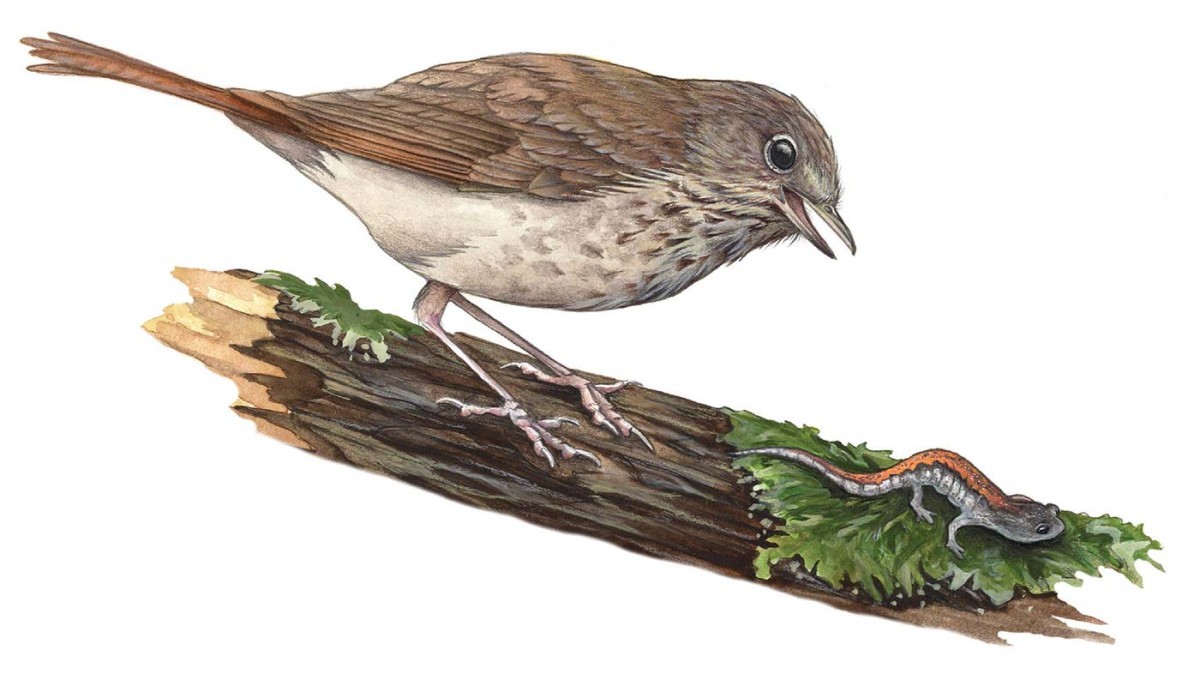“Hey Fred,” said Geoff Dennis over the phone. “I have a tame hermit thrush in my woods that is practically eating out of my hand. Would you like to come over and photograph it?”
Oh yeah.
The terms tame and hermit thrush are usually not found in close proximity. The hermit thrush is a shy creature, cryptically colored, and rare enough to evoke oohs and aahs when seen as a brown streak melting away into the woods. Although you may never have had a close look at a hermit thrush, chances are that you have heard its beautiful, lilting song: like Pan’s pipes, echoing through the deep northern woods.
Geoff Dennis is the premier bird photographer in the southeastern Massachusetts/Rhode Island area, so I am used to startling finds on his part, but this was something special. I grabbed my camera plus a fistful of Kodachrome 64 & Velvia 50 (this was the film era) and headed over to Geoff’s woodlot.
We set up our tripods and mounted our cameras about 20 feet away from a stump that the bird used as a feeding station. No blinds or artifices of any kind were set up. Geoff played a recording of the hermit thrush’s song; within a few minutes the bird showed up and readily accepted the earthworms that Geoff had placed on the stump.
The bird started to circle us at close range, traveling along the ground with short hops and trots, which allowed us to carefully observe its behavior. It would strike various attitudes such as an aggressive tail-raised posture in response to the tape, or a motionless crouch when anything large, such as a gull or airplane, flew high overhead. It also made assorted vocalizations such as a whispered version of its song or a soft whistle.
The most peculiar sound this hermit thrush made was a high-pitched buzz. By watching through our telephoto lenses, we discovered that the bird made this sound by strumming its foot up and down on a dry leaf. We thought this was a territorial response to the tape, but later that winter we found out its true purpose.
In early January as I watched the foot quiver through my 400mm lens, I saw the bird flush a red-backed salamander from the leaf litter. It pecked at the amphibian, looked around, and swallowed it in one rapid gulp. Wow, we could hardly believe it, so we did a simple experiment. Geoff and I fanned out through the woods frantically turning over logs looking for salamanders and worms. Then we put four red-backed salamanders on the feeding stump along with a half-dozen worms and a few clumps of holly berries. After things settled down, the thrush returned to find a banquet laid out for it. Without hesitation, it downed all four salamanders in rapid succession. Apparently full, it flew off without giving the worms or holly berries so much as a glance.
That night I looked up all the references to hermit thrush that I could find in my small natural history library. Although the foot quiver had been observed before, it had never been associated with feeding. Some old-school ornithologists had noted the occasional red-backed salamander in the stomachs of thrush they had shot, but there was nothing that associated this food with the foot quiver. Had we discovered something new? I knew that red-backed salamanders were a major biomass component of the northern hardwood forest; could this finding be significant?
The next day I could barely contain my excitement as I visited our local ornithologist, Dr. Alan Poole. He was in the process of editing Guide to Birds of North America for the Cornell Lab, and he was also unable to find a reference to this feeding behavior. Alan suggested I publish the results, so with that in mind, I contacted a technical birding journal for the New England area called Bird Observer. I proposed writing up my observations, and they were enthusiastic. With the help of Richard Holmes of Dartmouth and the editors at Bird Observer, I was able to track down all the relevant references and to format the results into a short, concise article. Getting the wording and references precisely correct was a bit tedious, but ultimately it was very satisfying to contribute in this small way to the understanding of the ecology of northern forests. Only rarely does nature lift her veil, but occasionally even amateurs such as myself get to glimpse her secrets.


